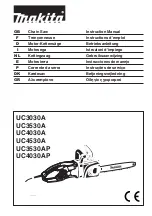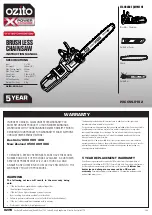
15
- Secure round timber.
- When working on slopes, always work facing the
slope.
-
For performing crosscuts the toothed ledge (Z,
Fig. 12) must be applied to the timber to be cut.
- Before performing a crosscut firmly apply the toothed
ledge to the timber, only then can the timber be cut
with the chain running. For this the electric chain
saw is lifted at the back handle and guided with the
tubular handle. The toothed ledge serves as a center
of rotation. Continue by slightly pressing down the
tubular handle and simultaneously pulling backwards
the electric chain saw. Apply the toothed ledge a little
bit deeper and once again lift the back handle.
- The sawing device must be running whenever you
remove the electric chain saw from the timber.
- When performing several cuts the electric chain saw
must be switched off in between.
-
When the timber must be pierced for cutting
or longitudinal cuts are to be performed it is
urgently recommended to have these works
carried out by specially trained persons only
(high risk of kickbacks).
- For performing
longitudinal cuts
(Fig. 13)
apply
the sawing device at an angle which is as small as
possible. Be very careful when carrying out this kind
of work because the toothed ledge cannot be used.
- When cutting with the bottom edge of the bar the
electric chain saw may be pushed in the direction
of the user if the chain is clamped. For this reason
use the top edge of the bar whenever possible. The
electric chain saw will then be pushed away from your
body.
(Fig. 14)
- If the timber is not free of tension
(Fig. 15)
, first cut
the pressure side (A). Then the crosscut can be
performed on the tension side (B). Thus clamping of
the bar is avoided.
- Be very careful when cutting splintery wood. Cut
pieces of wood may be pulled along (risk of injuries).
- Never use the electric chain saw for lifting up or
removing pieces of wood or other objects.
- When releasing the tension the electric chain saw
should be supported on the trunk (risk of kickbacks).
-
Tension releasing works must be carried out by
trained persons. High risk of injuries.
- Be aware of branches under tension. Do not cut free
branches from below.
- Never perform tension releasing works standing on
the trunk.
-
Do not use the electric chain saw for works in the
forest, i. e. for cutting down trees or carrying out
tension releasing works. The user’s mobility and
safety necessary for this kind of work are not
guaranteed due to the cable connection.
CAUTION:
Do not fell or debranch trees unless you are
specially trained for it! There is a high risk of
injury! Make sure to follow local regulations.
- Before cutting down a tree ensure that
a) only those persons are within the working range
which are actually involved in cutting down the tree
b) all persons involved in the felling have an
unhindered retreat route (the retreat path should
be about 45° diagonally and to the rear away from
the direction of fall). Be aware of the increased risk
of stumbling from electric cables!
c) the bottom part of the trunk is free from foreign
bodies, underbrush and branches. Make sure to
have a safe footing (risk of stumbling).
d) the next working place is at least 2 1/2 tree lengths
away.
(Fig. 16)
Before cutting down the tree
check the direction of fall and make sure that there
are neither other persons nor any objects within a
distance of 2 1/2 tree lengths.
(Fig. 16)
= Felling direction
= Danger zone
= Retreat path
- Judging the tree:
Direction of hanging - loose or dry branches - height
of the tree - natural hang over - is the tree rotten?
- Take into account the direction and the velocity of the
wind. If strong gusts are occuring, do not perform any
cutting down works.
- Cutting the roots:
Start with the strongest root. First perform the vertical
and then the horizontal cut.
- Notching the trunk (A,
Fig. 17
):
The notch determines the direction of fall and guides
the tree. The trunk is notched perpendicular to the
direction of fall and penetrates 1/3 -1/5 of the trunk
diameter. Perform the cut near the ground.
- When correcting the cut always do so over the whole
width of the notch.
- Cut down the tree (B,
Fig. 18
) above the bottom edge
of the notch (D). The cut must be exactly horizontal.
The distance between both cuts must be approx. 1/10
of the trunk diameter.
- The material between both cuts (C) serves as a
hinge. Never cut it through, otherwise the tree will fall
without any control. Insert felling wedges in the cut (B,
Fig. 18
) in good time.
- Secure the cut only with wedges made of plastic or
aluminium. Do not use iron wedges.
- When cutting down a tree always stay sideways of the
falling tree.
- When withdrawing after having performed the cut
down be aware of falling branches.
- When working on a sloping ground the user of the
electric chain saw must stay above or sidewards of
the trunk to be cut or the already cut down tree.
- Be aware of trunks which may roll towards you.
Kickback
- When working with the electric chain saw dangerous
kickbacks may occur.
- Kickback occurs when the tip of the blade(especially
the top quarter) inadvertently comes into contact with
wood or other solid objects.
(Fig. 19)
- In this case the electric chain saw is thrown without
any control and with high energy potentials in the
direction of the user (
risk of injuries
).
In order to prevent kickbacks follow the indicated
instructions:
- Never apply the end of the bar when starting to make
a cut. Always observe the end of the bar.
- Never use the bar end for sawing. Be careful when
continuing to cut.
- When starting to perform a cut the chain must be
running.
- Ensure that the chain is always sharpened correctly.
Pay special attention to the hight of the depth limiter
(for detailed information see the chap. “Sharpening
the saw chain”).
- Never cut several branches at the same time. When
Содержание UC3530A
Страница 3: ...3 1 2 3 4 5 6 7 8...
Страница 4: ...4 9 10 11 12 13 14 15 16 Z 2 1 2...
Страница 5: ...5 17 18 19 20 21 22 23 24 A A 45o B B C C D SERVICE...
Страница 6: ...6 25 26 27 28 29 30 31 32 1 2 3 4 7 6 9 8 6 9 10 11 3 12 13 3 14 2...
Страница 7: ...7 33 34 35 36 37 38 39 40 2 SERVICE 2 3 1 Waste oil...
Страница 8: ...8 41 42 43 44 45 46 47 48 1 2 4 3 1 2 4 3 5 1 6 1...
Страница 9: ...9 49 50 51 52 53 54 55 56 0 64 mm 0 64 mm min 3 mm 30 4 5...
Страница 10: ...10 57 58 59 60 61 1 2 1 2 1 2 SERVICE...
Страница 121: ...121 MAKITA MAKITA mm CE...
Страница 123: ...123 3 4 5 6 7 8 9 10 11 12 1 18...
Страница 124: ...124 16 2 1 5 3 2 3 4 22 4 5 6 5 16 FI 30 mA 6...
Страница 125: ...125 7 8 9 10 11 12 12 Z 12...
Страница 126: ...126 13 14 15 45 2 1 2 16 2 1 2 16 H A 17 H 1 3 1 5 H B 18 D H 1 10 C B 18 H 19...
Страница 127: ...127 H 20 21 22 MAKITA 23 MAKITA MAKITA 24...
Страница 129: ...129 25 26 1 2 31 3 3 4 7 6 27 9 6 8 28 9 10 29 11 32 14 12 30 3 13 30 11 31 32 2 3 14 2 2 33 34 2 4 mm 1 8 2 3 35...
Страница 131: ...131 43 2 44 3 4 45 1 MAKITA 2 3 4 46 5 1 5 1 1 6 47 MAKITA 48 1 MAKITA...
Страница 132: ...132 49 50 15 51 2 3 52 3 0 11 0 64 025 53 30 54 85 4 0 55 30 4 5 56 1 2 57...
Страница 133: ...133 58 1 2 944 360 000 944 350 000 59 1 2 MAKITA 60 61 1 2 1 5...
Страница 134: ...134 MAKITA...
Страница 135: ...135 MAKITA MAKITA MAKITA www makita outdoor com MAKITA MAKITA...
Страница 136: ...Makita Corporation Anjo Aichi Japan 884666C999...
















































